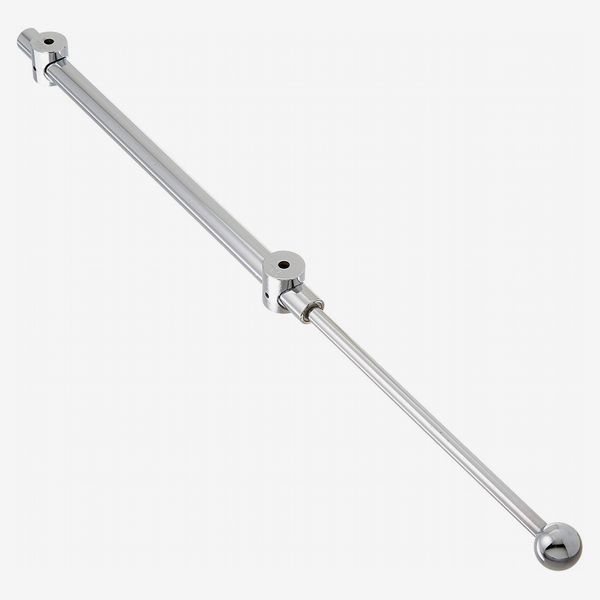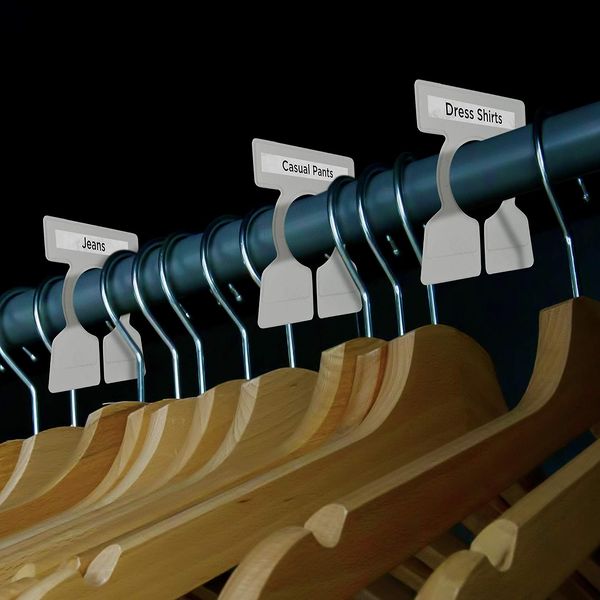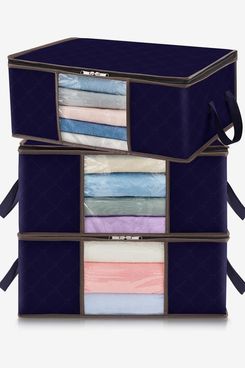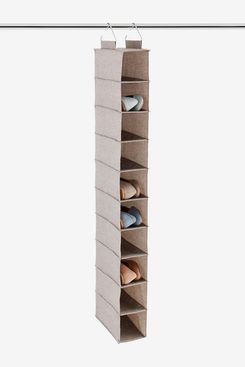
In this article
We hate to be the ones to say it, but you’re going to have to put your swimsuits and sandals away for the season. Plus, the sand toys, beach umbrellas, and all the other summer stuff that’s in a big heap by the door. The whole process of returning to the real world in September can be a crazy-making puzzle, especially when you don’t have loads of closet space or a basement to toss everything into. So this week, we’re sharing home organizational essentials to make the transition a little easier. It’s Straighten Out Your Space Week on the Strategist.
If you’re cleaning out your closet of shrunken T-shirts and moth-eaten sweaters, you should also make a plan for how to organize the “keepers.” There’s a host of promising closet storage solutions out there — from “daisy chains of hangers” to wall ladders that will help get an unsightly clothes chair under control. But which one is “best” depends on your organizational needs. Are you a folder or a hanger? What are you doing with your dry-clean-only work pants? Is your dream closet a dupe of Jenna Lyons’s? (If so, you should probably start with shoe storage.) Or do you prefer the organized chaos of Anna Sui’s? To help, we asked professional organizers about the closet-organization tools they’ve used to tame their clients’ spaces, from color-coded garment tags to Bottega Veneta–like woven leather baskets.
Update on August 27, 2024: Updated prices and checked stock for all products.
Best hangers for closet organization
Almost all of the organizers we talked to favored nonslip, velvet hangers for just about everything (wood came in a close second since wooden hangers are meant more for blazers and coats). Sharon Lowenheim, a.k.a. the Organizing Goddess, pointed us toward these, which can be bought in “shirt” and “suit” styles; packs of 10, 40, and 120; and nice-looking neutrals. “They are slim, taking up less room in your closet,” she says. “And, as the name implies, your clothes won’t slip off of them.” Lowenheim suggests hanging what you have in order of sleeve length: “The shorter the sleeve, the closer it should be to the front of the closet,” as long-sleeved clothing will hide short-sleeved styles.
“Always buy more hangers than you think you need,” says organizing expert Caroline Solomon. These hangers are among the most affordable, with a 30-pack starting at $25 and a 60-pack going for around $35. They’re cheap, but not cheaply made; Solomon praises them for not buckling under the weight of bulkier items. It’s an impressive feat, considering their slimness. (She advises buying the set in white instead of black, as the black can leave dark lint on clothes, and the white makes clothes “pop.” Though if your wardrobe has more of a Wednesday Addams vibe, get the black so there’s no light-colored lint to deal with.) Solomon agrees on hanging clothes according to length, but prefers to go from longest to shortest: “This way the eye is guided by a neat ascending line that really opens up your closet.”
Lisa Zaslow, owner of Gotham Organizers, likes these Amazon Basics hangers, “which are well made with a hook that you can turn easily (so all your clothes face the same direction).” Though these come in a number of colors, including burgundy and mint green, she likes the white so the focus is on the clothes. But having different hues might be better for a shared closet to know whose hangers belong to whom.
To avoid “misshapen shoulders,” Ann Lightfoot, a founding partner at Done & Done Home, counts on these hangers — which are among the gentlest she’s tried. She exclusively uses velvet hangers for silk and other fussier fabrics, and these ones keep their nonslip promise thanks to their flocked coating and notches to hold onto straps. They are sold in sets of 60 and come in colors like orchid and Barbie pink, resulting in a uniform look that’ll make your closet feel more organized before you hang a thing, Lightfoot says.
For clothes that are a little more tailored, Lightfoot likes these hangers with wider edges, which help maintain the original shape of clothing with strong-looking shoulders. “Smaller hangers tend to cause bumps,” she says. (These clip-on wooden pant hangers also have her stamp of approval, as plastic ones are much more likely to break.)
And although wire hangers were predictably divisive among the professionals (cue the scene from Mommie Dearest), they do serve a purpose, as the felted, slimmer kind can “cause friction, making getting the shirts on a hanger a bit more of a task,” according to organizer Laura Cattano. (The thinnest ones are easily broken, too.) Cattano gets “these indestructible tubular-metal” versions from a hanger wholesaler that sells them in 25- , 50-, and 100-piece sets. They come in a notched version too, for “skinny-strapped tops only,” she says. (If you need to save space, though, you can double up by hanging a button-down over a tank top.)
Natalie Schrier, founder of Cut the Clutter, told us that the pant-slash-skirt version of these Container Store hangers are “much more low-profile than most others on the market.” The delicate clips are designed to avoid leaving hard-to-iron indents. There’s a matching suit-style version, too, which is equally as space-saving.
Those “who aren’t going to be careful when they’re yanking things off a hanger” should get hangers that aren’t branded as “nonslip,” explains Schrier. She adds, “Any hanger that grips, be it plastic with partial rubber or velvet, is going to make it harder to get the garment off the hanger — that’s the point of them, to prevent the clothing from falling off.” Some of her clients just want to tug a T-shirt and have it slide it off — these slim suit hangers are a solution. She likes their look, which is “classier-looking than the traditional plastic ‘tubular’ hanger.”
Best hanging rod for closet organization
A valet rod is “this horizontal rod [that] you mount on the edge of a shelf, and then you can pull it forward when you need it,” explains Zaslow. The retractable rod “just gives you a little extra space to hang garments,” Zaslow says. This version from Rev-A-Shelf (a big name in the storage business) is installed with two screws. You could also use the pull-out as a place for planning outfits, or holding space for clothes you’ve worn but aren’t quite ready for the wash, or a perch for items that just came back from the dry cleaners, she adds.
Best hooks for closet organization
Command hooks are a classic. All you need to do is affix the included adhesive strip to a wall. Zaslow likes sticking some on the closet door itself to hold everyday essentials like the tote bag you never go without. Hooks are a way to free up space on shelves or on a closet rod, she says. You can get them in fancier finishes as well, including an “oil-rubbed bronze” metal model and a “satin brass” double style.
For a more zhuzhed-up look, Cattano mentioned the J Hook by Schoolhouse. (The label — makers of one of our favorite wall planners — makes what it describes as “modern American heirlooms.”) And if you buy them in multiples, you can hang them in a neat line, like so. For Cattano, the J Hook serves as a drop zone for a hanger — like Zaslow, she likes it as “a place to put dry cleaning before you have a chance to rehang everything,” or a spot “to hang something you’re steaming before wearing.” (Her steamer of choice is the Esteam from Jiffy, which she says is large enough to get through multiple garments in one round, but small enough to be stored anywhere.)
Best shelf dividers for closet organization
Generally, Lowenheim recommends keeping folded clothes in dresser drawers instead of inside of a closet. One exception is for voluminous sweaters — puffed-sleeved, cable-knitted — that might need more space. These dividers are her tool for making neat stacks on a shelf. Solomon notes that each one comes with a knob on the end where you can place a hanger with your outfit of the day or a dress you need to remember to take to the tailor.
Best garment labels for closet organization
These sorting labels can be slipped on (and off) the hanging rod in a closet, or used on the hangers themselves. The prewritten tags include categories like “long-sleeve,” “jeans,” and “dress shirts,” or you can make your own, as Zaslow suggests: “You can even do things like ‘Wear This Next’ for things you forget to wear,” she says. Her advice is to always group like with like: “Put all the pants together; put all the tops together.” This will give you a glance of what you have whenever the inevitable “I don’t know what to wear” situation comes up.
These colorful closet dividers are a “visual cue” to know where something belongs once you “assign a meaning” to each hue, according to Solomon. (Though, in the beginning, she suggests using a Sharpie to label them as a reminder of what each shade represents.)
Schrier uses a Brother P-Touch label-maker to organize shelves and the insides of drawers for clients who think dedicated garment dividers make their closets look like a department store. Other organizers we’ve talked to like the PTD210 model for its collection of fonts and convenient print-preview window. Eryn Donaldson, founder and CEO of home-organizing service the Model Home, believes it’s easy enough to use for a beginner.
Best storage boxes, bins, and bags for closet organization
Another of Lowenheim and Lightfoot’s recommendations for shelves in a closet is this box (similar to the Container Store’s beloved version for shoes). You can stack the boxes, and the drop fronts mean clothing won’t fall over even if you grab something from the one on the bottom, Lightfoot explains. Since it’s completely closed on all sides, the box keeps dust out. The drop-front also provides a window, so you’ll know what’s where. Lowenheim keeps multiple sweaters in each, folding them down and laying them into two separate stacks, side by side. However: “If a sweater is very big, then fold it so that it takes up the entire width of the box,” she recommends. “The folded edge of each sweater should go towards the front of the box so that you can see each one easily.”
These bags come in a pack of three for $16, making them a much more affordable alternative to the $35 drop-front box above. Those items you have up high, “no matter how neatly you may try to stack them,” are going to be “prone to avalanches,” says Zaslow. These bags are one of her solutions, featuring a zipper opening and a window to remind you of what’s inside. “You think you’ll remember, but you won’t,” Zaslow says.
The Our Deep Sweater Box from the Container Store is a favorite of Lightfoot’s. It’s made from what the brand calls an “unbreakable polypropylene,” or plastic (each features a locking lid as well) — she describes each as large and durable enough for entire categories of items, like hats, scarves, and gloves. But since they’re fully see-through, they work just as well for more miscellaneous assortments (a purse here, a jean there). You could use them to store your out-of-season clothing on a high shelf or stack them on the floor “if that’s the best use of space,” Lightfoot advises.
On the more eye-catching front are these elegant woven-leather baskets (reminiscent of Bottega Veneta’s Cassette) that Solomon says she’s obsessed with for how they “elevate” a closet. The cubes are “buttery soft” and lightweight for toting around; Solomon recommends the small for holding garment-care essentials like a lint roller, fabric shaver, and a shoehorn, and the large for sarongs and scarves.
These zippered storage bags — which come in small, medium, and large sizes — can sit right on a shelf. Their uncluttered appearance is one of the reasons Solomon approves of them — of note is a tag on the front “where you can mark the contents.” They’re made from sturdy burlap to help keep moths out, she adds.
Best shoe organizers for closets
Zaslow likes to store shoes low: “They’re walking around outside on the sidewalk; they’re dirty. I don’t like them to be up high where dirt falls down.” For the floor of a closet, she recommends these nondescript, low-profile shelves from the Container Store that can be stacked on top of one another. Even when stacked, the shelves leave enough clearance to hold taller shoes like high-tops or Chelsea boots. Each is made from “a very fine mesh, so that you don’t have to balance a heel,” as often happens with other shoe organizers, Zaslow says.
Lowenheim still stands by the hanging shoe organizer she told me about in our guide to the best shoe storage. It doesn’t take up much room on the end of a closet rod, and “because there are only ten slots, it reminds me that when I get a pair of shoes, another has to leave,” she says. You could also spring for the matching “drawer” inserts to cut down on visual clutter (though they may make it difficult to remember what’s in there).
Or save some space on the hanging rod with this over-the-door shoe “bag” that Lowenheim likes, which can hold up to 20 pairs (or ten pairs for larger shoes that each need their own pocket).
For the bottom of a closet, Solomon likes this architectural rack from Yamazaki. (A taller and just-as-handsome style from the brand was the best thing Strategist senior writer Liza Corsillo bought in 2022.) You can “fit more shoes on it than you might think at first glance,” Solomon says of the expandable stand. She recommends placing flats, loafers, and heels on the topmost tier while shoes like sneakers and boots go underneath to balance out the design.
Best drawer organizers
These dividers are pieces of plastic with rubber feet and adhesive mounting strips. They can be adjusted to fit almost any drawer, so you can assemble them in any arrangement you want. Be thoughtful when planning your layout and “be careful when you put them in,” warns Zaslow, because once installed, they won’t budge. Schrier agrees, “They’re the only dividers that don’t shimmy, trust me.” These dividers are also recommended in our guide to the best drawer organizers. Nicole Abramovici of Genius Organizing started using hers a decade ago and says her underwear drawer has been “immaculate ever since.”
Best underbed storage
“I understand the whole feng shui of it all — you don’t want to interrupt the slumber and have things cluttering up underneath the bed,” says Beth Penn of Bneato Bar. “That being said, sometimes you really don’t have the room.” An under-the-bed box like this is good for holding seasonal stuff like bathing suits, shorts, rain jackets, and winter coats, she says. Just be wary of hoarding. You can think of that space more as an attic: “It’s not really accessible, and it’s not for anything you would use often,” Penn recommends.
Best laundry hampers for closets
Having a hamper right near your clothes can help you efficiently sort what’s clean and what’s dirty. Cattano suggests having at least two: one for your usual laundry and another for separating what’s headed to the dry cleaners and what needs a hand-wash. This hanging bag can go right alongside the clothes in your closet, she says. Strategist writer Erin Schwartz is also a fan, calling out the bag’s “quality-of-life” features that make laundry day easier, including an adjustable hanger for different doorknobs and a back zipper to dump laundry into the washer without having to reach in and remove it piece-by-piece.
Solomon repeated the virtues of Yamazaki’s hamper, which she recommended in our guide to the best laundry baskets. It’s a hamper “that doesn’t really scream hamper,” she says. You can fold it completely flat or carry it to the washer almost like a tote. She recommended getting two, one in white and the other in black, to separate lights from darks.
The Basket from Danish design studio Hay can be stacked, with the small size nesting inside the large. (The small can also double as a storage bin, though at about 15 by 23 inches, it’s best for deeper shelves.) While the hamper takes up more floor space than Yamazaki’s, it has a lighter, airier look — as well as more literal airflow — thanks to the cutout grid design. You could use the pair to separate delicates from the rest of what needs laundering, or store drying sheets and a bottle of detergent (as I have done) inside the smaller of the two.
Best closet lights
It was one of Zaslow’s clients who actually turned her onto these stick-on, motion-detecting lights. You can change the brightness on each bar of light, from “soft” to “super.” Each one needs three batteries (which aren’t included), and Zaslow assures they will make even the smallest, darkest closets in a rental feel high-end.
Additional reporting by Maxine Builder
The Strategist is designed to surface the most useful, expert recommendations for things to buy across the vast e-commerce landscape. Some of our latest conquests include the best women’s jeans, rolling luggage, pillows for side sleepers, ultra-flattering pants, and bath towels. We update links when possible, but note that deals can expire and all prices are subject to change.
Every editorial product is independently selected. If you buy something through our links, New York may earn an affiliate commission.






































